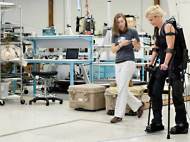Berkeley Bionics eLEGS exoskeleton could help paraplegics walk
 Berkeley Bionics developed the first practical exoskeleton and the first untethered exoskeleton in the world. Later on, through a licensed agreement with Lockheed Martin Corporation, they came up with HULC exoskeleton which is meant for military use. A few days ago they unveiled similarly looking eLEGS, a wearable, artificially intelligent, bionic device that powers paraplegics up to enable them to stand and walk.
Berkeley Bionics developed the first practical exoskeleton and the first untethered exoskeleton in the world. Later on, through a licensed agreement with Lockheed Martin Corporation, they came up with HULC exoskeleton which is meant for military use. A few days ago they unveiled similarly looking eLEGS, a wearable, artificially intelligent, bionic device that powers paraplegics up to enable them to stand and walk.
“Many of the 6 million Americans who live with some form of paralysis today were highly active and at the top of their game when they sustained their injury. As they research their options for increased mobility, they discover that wheelchairs are pretty much it. This has been the only alternative – their only hope – for nearly 500 years”, said Eythor Bender, CEO of Berkeley Bionics. “We want to enhance their independence and freedom of movement,” he added, “and with eLEGS, they can stand up and walk for the first time since their injury.”
Initially, the device will be offered to rehabilitation centers for use under medical supervision, and can be adjusted to fit most people with height between 157cm and 193 cm (5’2’’ and 6’4”) and weighing up to 100kg (220 ponds), in a matter of minutes. Users must be able to self-transfer from their wheelchair. Simple Velcro straps, backpack-style clips, and shoulder straps secure eLEGS to the user, over their clothing and shoes, and with a little practice, users can put eLEGS on and take it off in a minute or two.
It weighs only 20.5kg (45 pounds), making it easy to move around and transport. Thanks to its narrow waist and snug fit, the wearer can maneuver easily through doors and corridors, and most ordinary chairs are accessible. No special armrests will be required to assist you in standing up or sitting down.
eLEGS provides currently largest knee flexion, which translates into the most natural human gait available in any exoskeleton today, making it better equipped to handle mixed terrains. It is also relatively quiet while in operation. Walking speeds depend on each patient’s aptitude and condition, but speeds in excess of 3.2 kilometers per hour (2 miles per hour) can be attained, and speeds can be varied.
The device is battery-powered and employs a gesture-based human-machine interface which (utilizing sensors) observes the gestures the user makes to determine their intentions and then acts accordingly. The current eLEGS prototype is able to stay charged over 6 hours (under nominal usage in a rehabilitation setting).Four motors (one for each hip and knee) are used to enable walking while the ankle joint is controlled with passive springs that keep the foot angled as in normal walking (heel to toe) as the leg steps. A real-time computer draws on sensors and input devices to coordinate every aspect of a single stride.
Clinical trials will commence early next year at select rehabilitation clinics in the United States. A limited release of eLEGS is scheduled during the second half of 2011 at several of the most respected rehabilitation facilities around the country. At that time, eligible patients will have the opportunity to enroll in a medically-supervised eLEGS gait training program, working with their physical therapist. Therapists will undergo training in order to become eLEGS-certified prior to assisting patients.









Excellent Application of Bionics. Helps handicapped.
Dr.a.Jagadeesh Nellore(AP),India